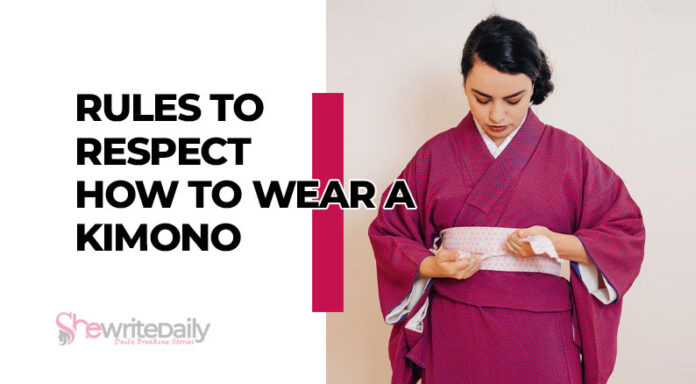The kimono, a traditional Japanese garment, holds great cultural significance and is worn on various occasions. To fully appreciate and respect the kimono, it is essential to understand the rules and etiquette associated with wearing it.
This article aims to provide readers with a comprehensive guide on how to wear a kimono properly and respectfully. By adhering to the four rules outlined in this article, individuals can ensure that they dress appropriately for the occasion, demonstrate proper dressing techniques and etiquette, choose suitable accessories and hairstyles, maintain respectful behavior and posture, and appreciate the artistry and craftsmanship of the kimono.
Ultimately, embracing the kimono as a symbol of Japanese culture allows individuals to not only honor tradition but also showcase their admiration for the rich heritage and history associated with this iconic garment.
Understanding the Cultural Significance of the Kimono
The cultural significance of the kimono lies in its historical and symbolic value within Japanese society.
The kimono represents a form of cultural appreciation and serves as a reflection of Japan’s rich history.
It is a garment that has been worn for centuries, with each design and color carrying its own meaning.
The kimono embodies the traditions and customs of Japan, making it a symbol of historical significance and cultural pride.
Choosing the Right Kimono for the Occasion
When selecting a kimono, it is important to consider the appropriateness for the specific occasion.
Different kimono styles are suitable for different events, reflecting the formality and cultural significance associated with each occasion.
For formal events such as weddings or tea ceremonies, a traditional, elaborate kimono with intricate patterns and vibrant colors would be appropriate.
On the other hand, for more casual events or daily wear, a simpler, understated kimono would be more suitable.
Proper Dressing Techniques and Etiquette
Properly adhering to dressing techniques and etiquette in kimono attire demonstrates a deep appreciation for the cultural heritage and embodies a sense of reverence for the occasion at hand.
The dressing styles of a kimono vary depending on the formality and purpose of the event.
The intricate process of wearing a kimono involves specific steps, such as folding, tying, and adjusting the garment.
These techniques have been passed down through generations and hold historical significance in Japanese culture.
Accessories and Hairstyles to Complement the Kimono
To enhance the overall aesthetic of a kimono ensemble, one can incorporate carefully selected accessories and hairstyles that complement the traditional garment. Hairstyle options for wearing a kimono can vary, but they often involve elegant updos or intricate braids. As for accessories, there are several options to choose from, such as obi belts, decorative hairpins, and traditional Japanese sandals. These elements can add a touch of sophistication and cultural authenticity to the kimono attire.
| Hairstyle Options | Matching Accessories |
|---|---|
| Elegant updos | Obi belts |
| Intricate braids | Decorative hairpins |
Maintaining Respectful Behavior and Posture
Maintaining appropriate behavior and posture is essential in order to fully embody the cultural significance and elegance associated with the traditional attire. To maintain proper demeanor and respect kimono history, individuals should adhere to the following guidelines:
- Sit and stand with a straight back to demonstrate grace and poise.
- Avoid slouching or crossing arms to maintain a respectful and open demeanor.
- Walk with small, measured steps to showcase elegance and control.
- Refrain from excessive gesturing or loud talking to preserve the tranquil ambiance of the kimono-wearing experience.
Appreciating the Artistry and Craftsmanship of the Kimono
The kimono is not only an article of clothing, but also a testament to the artistry and craftsmanship of Japanese culture.
Appreciating the history, symbolism, and motifs of the kimono allows one to delve into the rich cultural heritage of Japan.
Exploring the different types and styles of kimonos throughout history reveals the evolution and diversity of this traditional garment, showcasing the skill and creativity of Japanese artisans.
Embracing the Kimono as a Symbol of Japanese Culture
The appreciation for the artistry and craftsmanship of the kimono seamlessly transitions into embracing it as a symbol of Japanese culture. This traditional garment is not only a reflection of Japan’s rich history and heritage, but it also serves as a means of celebrating diversity. In recent years, kimono fashion trends have gained popularity worldwide, with people from different cultures and backgrounds embracing this iconic attire as a way to honor and appreciate Japanese culture.
| Traditional garment | Celebrating diversity |
| Rich history and heritage | Kimono fashion trends |
| Reflection of Japanese culture | Honoring and appreciating Japanese culture |
Conclusion
In conclusion, wearing a kimono is not just about putting on a piece of clothing; it is a representation of Japanese culture and tradition.
By understanding the cultural significance of the kimono, choosing the right one for the occasion, and following proper dressing techniques and etiquette, one can show respect for this iconic garment.
Additionally, paying attention to accessories, hairstyles, and maintaining respectful behavior and posture further enhances the overall experience.
By embracing the kimono as a symbol of Japanese culture, one can truly appreciate the artistry and craftsmanship behind this timeless attire.


